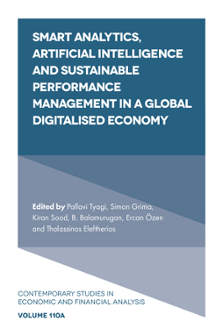
Index
ISBN: 978-1-80382-556-4, eISBN: 978-1-80382-555-7
ISSN: 1569-3759
Publication date: 29 May 2023
Citation
(2023), "Index", Tyagi, P., Grima, S., Sood, K., Balamurugan, B., Özen, E. and Eleftherios, T. (Ed.) Smart Analytics, Artificial Intelligence and Sustainable Performance Management in a Global Digitalised Economy (Contemporary Studies in Economic and Financial Analysis, Vol. 110A), Emerald Publishing Limited, Leeds, pp. 303-313. https://doi.org/10.1108/S1569-37592023000110A017
Publisher
:Emerald Publishing Limited
Copyright © 2023 Pallavi Tyagi, Simon Grima, Kiran Sood, B. Balamurugan, Ercan Özen, and Thalassinos Eleftherios
INDEX
- Prelims
- Chapter 1: A Review of Business Model Disclosures in Integrated Reporting
- Chapter 2: Adaptive Market Hypothesis and Cointegration: An Evidence of the Cryptocurrency Market
- Chapter 3: Modelling the Barriers of Artificial Intelligence Adoption in the Organisations: An Interpretive Structural Modelling and MICMAC Analysis
- Chapter 4: Performance Improvement in Budget Hotels Through Consumer Sentiment Analysis Using Text Mining
- Chapter 5: Studying the Effect of Artificial Intelligence on E-Governance
- Chapter 6: The Development of Digital Banking: A Case Study of Vietnam
- Chapter 7: Augmenting Cybersecurity: A Survey of Intrusion Detection Systems in Combating Zero-day Vulnerabilities
- Chapter 8: Investigation of the Role of Compliance Unit as a Mediator Between E-Government and Money Laundering
- Chapter 9: E-Governance and Fiscal Performance in Sub-Saharan Africa: Reappraising the Role of ICT in Public Sector Management
- Chapter 10: Artificial Intelligence and Machine Learning in Insurance: A Bibliometric Analysis
- Chapter 11: The Effect of Money Laundering on the Economic and Financial Performance of an Economy: A Bibliometric Analysis
- Chapter 12: Financial Inclusion, Sustainability and Sustainable Development
- Chapter 13: Gender Inequality in Management and Sustainable Competitiveness
- Chapter 14: Artificial Intelligence: The New Tool of Disruption in Educational Performance Assessment
- Chapter 15: Machine Learning-Based Smart Appliances for Everyday Life
- Index